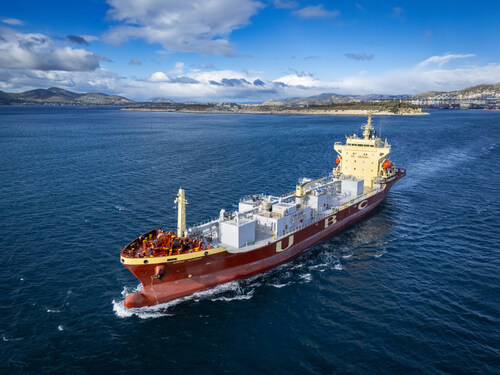The solution equips the UBC Cork, a 5,700 gross tonne (GT) cement-carrying ship owned by Hartmann and managed by InterMaritime, with Seabound’s compact carbon capture system. The captured carbon — bound in limestone and thus stored safely onboard — will be offloaded at the Port of Brevik, Norway, and used in Heidelberg Materials’ Brevik cement plant. Recently inaugurated, this world-first industrial-scale carbon capture facility in the cement industry will produce net-zero concrete.
Seabound partnered with Hartmann Group, InterMaritime Group, and Heidelberg Materials Northern Europe on the project.

Seabound is deploying its compact marine carbon capture system aboard the UBC Cork (pictured), a 5,700 GT cement carrier owned by Hartmann Group, managed by InterMaritime Group, and chartered out to Heidelberg Materials. The captured carbon will be offloaded as limestone at the Port of Brevik, Norway, for use at Heidelberg Materials’ nearby cement plant.
Marine shipping accounts for nearly 3% of global CO2 emissions, making it one of the most carbon-intensive and difficult-to-decarbonize sectors. In April, the International Maritime Organization (IMO) introduced a global carbon price of up to $380 per tonne of CO2, further adding pressure to shipowners. With few scalable alternatives to heavy fuel oil and existing efficiency measures proving insufficient, shipowners and global brands are seeking viable solutions to cut maritime emissions and meet ambitious climate goals.
Seabound’s containerised carbon capture system uses calcium looping technology to capture up to 95% of CO2 and 98% of sulphur emissions from ship exhaust. The process uses calcium hydroxide, derived from calcium oxide and commonly known as slaked lime, to absorb CO2 and convert it into limestone that is stored onboard until returning to port. The containerised system allows for easy installation with minimal vessel modification and is suitable for all vessel types. This design decouples carbon capture from post-processing, resulting in lower energy requirements, faster deployment, and reduced cost compared to traditional liquefied CO2 systems.
“We’re proud to partner with industry leaders like Heidelberg Materials and Hartmann to deliver scalable carbon capture solutions,” said Alisha Fredriksson, CEO and Co-founder of Seabound. “We’re especially excited to be advancing this work in Brevik, a strategic location that’s rapidly establishing itself as a global hub for CCS with Heidelberg’s world-first facility and the Northern Lights pick up point. Together, we’re demonstrating how onboard carbon capture can accelerate emissions reductions in carbon-intensive sectors.”
The carbon captured on the UBC Cork will be offloaded as limestone at Heidelberg Materials’ Brevik plant, where it will serve as an input in the production of carbon captured cement, which enables net-zero concrete. The Brevik CCS facility is already operational, capturing 400,000 tons of CO2 annually. CO2 transport and storage are provided by Northern Lights, the world’s first cross-border CO2 storage hub beneath the North Sea. As part of its Net Zero strategy, Heidelberg Materials said it is committed to decarbonising their maritime transport and supply chain, targeting a substantial reduction in CO2 emissions from 2020 levels.
“Shipping cement is emissions-intensive, and Seabound’s system gives us a clear path to reduce those Scope 3 emissions while enhancing our circular use of captured CO2,” said Lars Erik Marcussen, Project Manager, Logistics at Heidelberg Materials Northern Europe. “This project brings us one step closer to also decarbonising the logistics/transport part of our operations.”
Heidelberg Materials aims to reduce its Scope 3 emissions from maritime transport by using a variety of methods — including Seabound’s carbon capture technology — to accelerate its path to net-zero. Meanwhile, Hartmann’s early adoption provides crucial operational expertise and strategically positions the company to meet evolving regulatory demands. Together, Seabound and Hartmann are committed to expanding carbon capture solutions throughout Hartmann’s fleet, driving meaningful decarbonisation in maritime shipping.
“Hartmann is committed to embracing and investing in environmentally friendly technologies that reduce our maritime carbon footprint and promote sustainability,” said Captain Jayant Singh, Director, Pool Manager Operations at Hartmann Group. “By integrating innovative, eco-conscious solutions into our ship owning operations, we aim to contribute positively to the environment while delivering long-term value to the maritime industry and all of our stakeholders.”
“This collaboration will play a key role in advancing carbon capture technology and accelerating its adoption in the shipping industry, marking a critical step toward realising a low-emission future for maritime transport,” added Dieter Rohdenburg, CEO of Intership Navigation Co. Ltd., a member of InterMaritime.
The project is co-funded by the Eurostars partnership on Innovative SMEs which is part of Horizon Europe through the Cyprus Research and Innovation Foundation. This funding supports collaborative R&D projects that drive innovation in a range of industries, including maritime transport. The consortium of funding recipients supporting this initiative includes the Cyprus Marine and Maritime Institute, a centre of excellence in maritime research with an interest in advancing new decarbonisation technologies.
Seabound completed its first onboard carbon capture pilot with Lomar Shipping and Hapag Lloyd, successfully capturing CO2 at ~80% efficiency onboard a 3,200 twenty-foot equivalent unit (TEU) container vessel. The company also showcased its technology for port-based emissions capture alongside STAX Engineering at an event in the Port of Long Beach, California in April.

